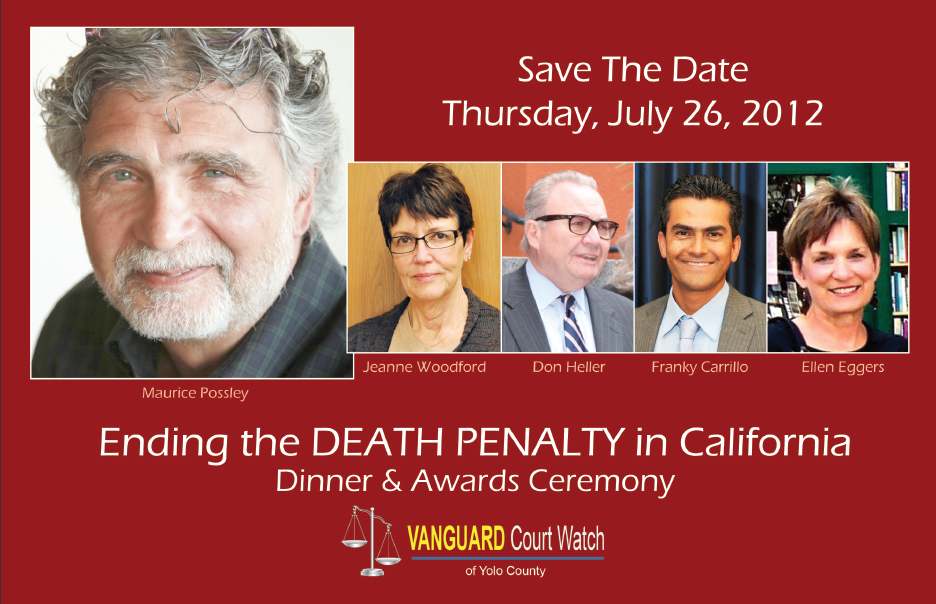
California Secretary of State Debra Bowen today certified a fifth measure for the November 6, 2012, General Election ballot. The measure would repeal the death penalty, according to a news release from the California Secretary of State’s Office.
In order to qualify for the ballot, the death penalty repeal initiative needed 504,760 valid petition signatures, which is equal to five percent of the total votes cast for governor in the November 2010 gubernatorial election.
“The death penalty repeal initiative needed at least 555,236 projected valid signatures to qualify by random sampling, and it exceeded that threshold today,” the Secretary of State’s office announced late Monday.
Earlier in the day, anticipating this news, the Safe Coalition held a phone conference call.
“California is on the brink of replacing the death penalty with a sentence of life in prison with no chance of parole as the maximum punishment for murder,” Jeanne Woodford, former warden at San Quentin state prison and the official proponent of the Savings, Accountability and Full Enforcement for California Act (the SAFE California Act) announced Monday morning.
“In November, voters will have the first opportunity ever to decide between the death penalty and a sentence of life in prison with absolutely no chance of parole,” Ms. Woodford said. “Back in 1978, we did not have an alternative sentence that would keep convicted killers behind bars forever. We certainly did not know that we would spend $4 billion on 13 executions. Our system is broken, expensive and it always will carry the grave risk of a mistake. SAFE California offers a solution with savings at a time when we’re laying off teachers and cutting vital services.”
“I oversaw four executions at San Quentin. I can tell you as a law enforcement officer with 34 years of experience those executions did not make any one of us safer. What they did do was consume millions of dollars in resources that would be better spent on solving crime,” Ms. Woodford added. “Now, Californians will have a real chance to improve personal safety by replacing the death penalty with life in prison without parole, and directing some of the savings to solving more rape and murder cases.”
Representative Gary Holder-Winfield, the lead legislative sponsor of this year’s successful Connecticut bill to replace the death penalty also joined the call to replace California’s Death Penalty. Connecticut became the fifth state in five years to replace the death penalty, following New York, New Jersey, New Mexico, and Illinois.
“Across the country states are moving away from the death penalty because more and more people realize that it’s hollow,” he said. “The promise to victims is hollow and the promise to taxpayer’s is hollow.”
“Murder victim’s family members led the effort in Connecticut,” he said. “They shared their experiences with us. Mothers, fathers, brothers, sisters, they all know first-hand what the death penalty does and the family members came and shared those experiences, some of them went right back to the moment after the tragic event and experienced it all over again to tell us not to have a death penalty.”
“In Connecticut they raised their voices to say that the death penalty offers them nothing,” Representative Holder-Winfield added noting it takes away resources from programs that could actually help victims of crime and their families.
He said he was urging California to go the way of diverse states such as Connecticut, New Mexico and Illinois and “become the 18th state to do away with the death penalty.”
Former Attorney General John Van de Kamp also joined the conference call noting that we have had just 13 executions in California since 1978.
“It takes over 20 years between judgment and execution and that number is growing,” he said.
“I have opposed the death penalty for a number of reasons,” he said, “But even those supporting the death penalty have come around to replace it with life with parole [because] it doesn’t work.”
“There’s no good evidence that the death penalty deters,” he added. “States without the death penalty have lower homicide rates than those who have it.”
He said an additional point is that the measure provides roughly $100 million to the general fund to go to crime fighting measures to reduce homicide and rape rates in the state.
“In 2010, the average murder rate in death penalty states was 4.6 per hundred thousand while the murder rate average for non-death penalty states was 2.9 per hundred thousand,” he said noting that this deferential has remained over the years. “There is no good evidence that the death penalty, particularly as it’s administered in this country, in California in particularly, actually deters homicide.”
On a fiscal note, Mr. Van de Kamp cited a study that suggested that each homicide costs the state about $8 million. “At that rate, in Los Angeles alone, the homicides cost the city $4 billion in 2006 or two percent of the city’s total economic output,” he said.
Meanwhile, he said, 46% of the homicides statewide are unsolved. For rape cases, the figure is 56%.
“Clearly efforts to reduce those rates which this measure would provide for, would in demonstrative ways reducing homicide as well as reducing the significant cost to the communities where there are significant numbers of homicides,” Mr. Van de Kemp continued. “In short, this is a very good investment and that’s one of the reasons why this measure should pass.”
Gil Garcetti, the former Los Angeles District Attorney who has been out of office nearly 12 years, explained why he changed his position from supporting the death penalty to opposing it.
“I have been moving toward a change from the death penalty to life without the possibility of parole for a few years,” Mr. Garcetti said. “My conclusion was that the law was wholly ineffective and, not knowing the exact numbers, I just thought it was obscenely expensive.”
However, fiscal reasons alone do not account for Mr. Garcetti’s change.
“I also have to share with you that I was greatly troubled by the number of factually determined innocent death row inmates in such states as Illinois and New Mexico,” he said.
With the large number of death row inmates in California, “I just feel there’s at least one factually innocent person on California’s death row.”
He added, “Most California death row inmates are going to die of natural causes, not by execution.”
In referencing his work in Los Angeles, “I felt there was an inherent unfairness of the system where I felt that whether an accused person was convicted of the death penalty by a jury could be determined by the local jurisdiction where the case is tried.”
He said, “We could get different verdicts in the exact same case tried in two different LA County judicial districts – that was real bothersome to me.”
He also worried about the families and friends of the victims. “They can never ever have closure – I understand and I appreciate that,” he said. “At least changing the death penalty to life without the possibility of parole will give the surviving family and friends of murder victims legal finality, and that’s a big thing.”
“My decision to publicly support changing the death penalty to life without the possibility of parole was, frankly, the publication of the Alarcon Report,” he said.
“I saw that in the news, I read it cover to cover and concluded, right, there’s no useful purpose, it’s not a deterrent, it’s even more obscenely expensive than I thought. Money could be used much much more productively, given the state’s dire financial conditions and so I decide to go public and say we should support a change in the death penalty law to life without the possibility of parole.”
Paula Mitchell worked with Judge Alarcon on a follow-up study to the original Alarcon Report. She is a law professor at Loyola Law School and their study published in the Loyola Law Review in June 2011 is considered a definitive study on the costs of California’s death penalty. While she was not able to join the conference call she did issue a statement.
Judge Alarcon works in the 9th District and was once a prosecutor of capital cases. He is also not personally opposed to the death penalty.
The purpose of the study was “to equip voters with accurate information about what they are spending to maintain death row from an impartial academic perspective,” she said. “The report is exhaustive, we examined state, federal, and local expenditures in capital cases that we conducted in over three years. We found the additional costs of a capital trial, enhanced security on death row compared with life without parole inmates, and legal representation for death row inmates adds $184 million to the budget each year.”
They also found that the death penalty in California, “despite its great expense has been underfunded since the moment it was enacted… Over the past 34 years, the legislature has not put into place a single recommendation for its improvement.”
She continued, “The death penalty in California has been a big ticket under performer with no realistic chance of change.”
The cost to taxpayers she said is $4 billion since 1978 for a system that has produced exactly 13 executions.
California with its 720 death row inmates has 22% of the nation’s death row inmates yet it has carried out 1% of all executions nationwide since 1978.
The findings of their study are consistent with other studies such as one from the CCFHA which “concluded that not only does the broken death penalty system in California cost over $100 million per year, but that it is underfunded by about $100 million per year.”
One of their concerns about the fair application of the death penalty was the risk of executing an innocent person.
“Judge Alarcon and I came to share the same conclusions based on three decades of available data,” Professor Mitchell said. “The death penalty in California is broken and we cannot fix it.”
She noted both the current and past chief justices of the California Supreme Court, Ron George and Tani Cantil Sakauye, came to the same conclusion.
Professor Mitchell argued that this was significant because “at times people suggest that the legal process and our capital appeals can be adjusted somehow. This is a notion that is rejected by the most senior judges in our state.”
The SAFE California Act will replace California’s death penalty with life in prison with no chance of parole. Convicted killers will remain in high security prisons until they die – with no risk of executing an innocent person. SAFE California also requires persons convicted of murder to work and pay restitution into a victim’s compensation fund and creates the SAFE California Fund, which takes $30 million a year for three years in budget savings and puts it into the investigation of unsolved rape and murder cases.
Polls conducted last year by the Public Policy Institute of California and Field Poll showed California voters’ prefer life without the possibility of parole over the death penalty. Every recent statewide public opinion survey has shown that, when given the chance, more voters prefer a maximum sentence of life in prison without parole over California’s exorbitantly costly death penalty.

On July 26, 2012, you will have the chance to learn more about this initiative and the death penalty in California.
The Vanguard will host its Annual Dinner and Awards Ceremony at Heidrick AG History Center on 1962 Hays Lane in Woodland from 5:30 to 9 pm on that evening.
Maurice Possley leads an all-star line-up for the July 26 event. Maurice Possley is a Pulitzer Prize-winning journalist who has been an investigative reporter for 36 years specializing in criminal justice, wrongful convictions and wrongful executions. Joining him are Don Heller who wrote the 1978 Briggs Initiative that was passed by voters to become California Death Penalty Law; Former San Quentin Warden Jeanne Woodford who heads up the Death Penalty Focus; California Public Defender Ellen Eggers who represents death row inmates, and Franky Carrillo who was exonerated after serving 19 years on a murder charge.
At the banquet, the Vanguard Court Watch will acknowledge people and organizations that have made a significant change or contribution to ensuring the integrity of our justice system and the greater cause of social justice.
Single tickets are $35 apiece. There is limited seated therefore tickets or RSVPs need to be received in advance.
Sponsorship levels vary from $5000 for the top level to $100 at the bottom level.
To purchase tickets or sponsorships click here, or email us or call (530) 400-2511.
—David M. Greenwald reporting





[quote]He said an additional point is that the measure provides roughly $100 million to the general fund to go to crime fighting measures to reduce homicide and rape rates in the state.[/quote]j
A big positive in addition to everything else…